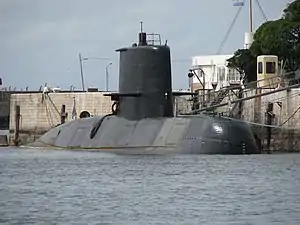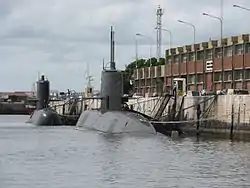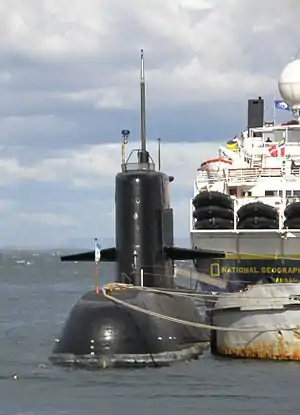TR-1700-class submarine
The TR-1700 (Santa Cruz) is a class of diesel-electric patrol submarines built by Thyssen Nordseewerke for the Argentine Navy in the 1980s, with two submarines completed. These ships are amongst the largest submarines built in Germany since World War II and are among the fastest diesel-electric submarines in the world.[1] ARA San Juan was lost on 17 November 2017, leaving ARA Santa Cruz as the only remaining submarine of this class. As of 2020, the refit of Santa Cruz had been reported cancelled leaving the entire class inactive. [2][3]
 TR-1700 submarine ARA Santa Cruz (S-41) at Base Naval Mar del Plata. | |
| Class overview | |
|---|---|
| Builders: |
|
| Operators: |
|
| In commission: | 1984–present |
| Planned: | 6 |
| Completed: | 2 |
| Cancelled: | 2 |
| Active: | 0 |
| Laid up: | 3 |
| Lost: | 1 |
| General characteristics | |
| Type: | Submarine |
| Displacement: |
|
| Length: | 67.30 m (220 ft 10 in) |
| Beam: | 8.36 m (27 ft 5 in) |
| Draught: | 6.5 m (21 ft 4 in) |
| Propulsion: |
|
| Speed: |
|
| Range: | 12,000 nmi (22,000 km; 14,000 mi) at 8 kn (15 km/h; 9.2 mph) surfaced |
| Endurance: | 30 days |
| Test depth: | 300 m (980 ft) |
| Complement: | 26 |
| Sensors and processing systems: |
|
| Armament: |
|
Development
The original 1977 plan called for six boats, two TR-1700s built in Germany by Thyssen Nordseewerke, two in Argentina by Astillero Domecq Garcia, and two smaller TR-1400s also built in Argentina.[4] The final agreement in 1982 was modified to six TR-1700s, with the last four to be built in Argentina.[5] The TR-1700s to be built in Argentina were considered for an upgrade to a nuclear submarine using INVAP's CAREM reactor, which began development at that time. The nuclear submarine project never came to fruition, despite later attempts to revive it.[6]
Design
The submarine was designed by Thyssen and its features include high underwater speed, endurance (for a diesel submarine), and survivability. The boat's four MTU diesel engines, four generators, and Siemens electric motor can propel it at speeds up to 25 knots (46 km/h; 29 mph).[7] Eight 120-cell batteries are installed on each boat. They have a diving depth of 300 m (980 ft). Normal endurance of these boats is 30 days with an extended range up to 70 days. These boats are equipped to accept a Deep Submergence Rescue Vehicle (DSRV). Armaments include six bow 533 mm (21 in) torpedo tubes and 22 SST (Special Surface Target) or Mark 37 torpedo. The automatic torpedo reload system can reload the tubes in 50 seconds.[4]
Thyssen proposed the TR1700A for the Australian Collins-class submarine program.[8] The proposed design had a reworked pressure hull, was six meters longer, and half a meter wider than the TR-1700s built for Argentina. It lost to the Type 471 from Kockums, an enlarged Västergötland-class submarine.
Service
The first two submarines were delivered on schedule in 1984–85. The remaining four built in Argentina were suspended due to the Argentinean economic crisis of the 1980s. In 1996 work completely ceased on ARA Santa Fe at 70% (or 52%) completion while ARA Santiago del Estero was only 30% complete. After attempts to complete and sell the boats to Taiwan failed, they were cannibalized, along with the parts for the fifth and sixth units, to support the continued operations of the first two submarines.[1]
Santa Cruz received its mid-life modernization at Arsenal de Marinha, Rio de Janeiro Brazil between September 1999 and 2001.[4] The work involved the replacement of the engines, batteries, and sonar. Her sister boat San Juan entered the Astillero Domecq Garcia shipyard to receive her refit in 2007;[10] she completed refit in 2013.[11]
In September 2010, it was revealed that the Ministry of Defense was conducting feasibility studies to decide if ARA Santa Fe (S-43) should be completed. The decision should be made sometime after completing the mid-life modernization of ARA San Juan (S-42). The estimated cost of completing Santa Fe was $60 million.[12][13]
On 17 November 2017, the ARA San Juan was reported missing; reports of a fire at the time were denied by the Argentine Navy.[14][15] A year after that, on 17 November 2018, private company Ocean Infinity (appointed by the Argentine Government) announced that they successfully located the wreck, at 900 metres depth and 500 km from Comodoro Rivadavia.[16]
Boats in class
| Ship | Pennant number | Builder | Completed | Status |
|---|---|---|---|---|
| ARA Santa Cruz | S-41 | Thyssen Nordseewerke | 18 October 1984 | Inactive; envisaged refit cancelled as of 2020.[17][18] |
| ARA San Juan | S-42 | Thyssen Nordseewerke | 19 November 1985 | Formerly in service with Argentine Navy. Confirmed lost on 23 November 2017; wreck found in Atlantic Ocean on 16 November 2018. Recovery by American team pending naval decision. |
| ARA Santa Fe | S-43 | Astillero Domecq Garcia | Construction suspended - 70% (or 52%) complete[19] Boat could be completed after feasibility studies. Unknown if sub was cannibalized for parts along with the rest of incomplete members of the class. | |
| ARA Santiago Del Estero | S-44 | Astillero Domecq Garcia | Construction suspended - 30% complete and eventually cannibalized for spare parts for active subs. | |
| (none) | S-45 | Astillero Domecq Garcia | Construction suspended - Little complete Components cannibalized for spares | |
| (none) | S-46 | Astillero Domecq Garcia | Suspended Components cannibalized for spares |
Gallery
 Argentine Navy ARA San Juan in 2007
Argentine Navy ARA San Juan in 2007 Argentine Navy TR-1700 submarines ARA Santa Cruz (S-41) and ARA San Juan (S-42)
Argentine Navy TR-1700 submarines ARA Santa Cruz (S-41) and ARA San Juan (S-42) ARA Santa Cruz in Ushuaia, 2008
ARA Santa Cruz in Ushuaia, 2008
See also
References
Citations
- Miller, David (2002). The Illustrated Directory of Submarines. Zenith Press. p. 480. ISBN 0-7603-1345-8.
- https://www.nuestromar.org/defensa-y-seguridad/estiman-que-la-llegada-del-proximo-submarino-operativo-para-argentina-demoraria-de-cinco-a-seis-anos/
- https://www.infodefensa.com/latam/2020/12/23/noticia-rossi-argentina-argentina-tiene-tener-fuerza-aerea-aviones-supersonicos.html
- "Santa Cruz class Patrol submarine". Archived from the original on 2008-10-14. Retrieved 2008-10-03.
- Farley, Robert (20 November 2017). "Everything You Need to Know about Argentina's Submarine Force". The National Interest. Archived from the original on 24 November 2017. Retrieved 23 November 2017.
- "Promete Garré que se construirá un submarino nuclear en el país". Archived from the original on 2012-12-26. Retrieved 2017-11-19.
- Watts, Anthony (March 2002). Jane's Underwater Warfare Systems, 2002-2003. Jane's Information Group. p. 629. ISBN 0-7106-2451-4.
- Woolner, Derek (18 September 2001). Procuring Change: How Kockums was Selected for the Collins Class Submarine. Canberra: Department of the Parliamentary Library. p. 34.
- "The hull of the S-42 ARA San Juan again soldier". Archived from the original on 2012-04-26. Retrieved 2012-02-24.
- El arte de reparar submarinos. p. 12, 3 August 2014 Archived 11 May 2016 at the Wayback Machine (2016-05-01)
- Por primera vez en la historia se construirán en nuestro país submarinos para la Armada Archived 2011-07-23 at the Wayback Machine
- "Argentina estudia construir submarino nuclear en astilleros propios". FuerzasAeronavales website, by Sergio Garcia Pedroche, 28/09/2010 Archived 2016-08-16 at the Wayback Machine (accessed 2016-07-16)
- Goñi, Uki (2017-11-17). "Argentina's navy searches for missing submarine with 44 crew on board". The Guardian. ISSN 0261-3077. Archived from the original on 2017-11-17. Retrieved 2017-11-17.
- La Armada Argentina asegura que, a pesar de la explosión, continuará buscando el submarino San Juan. "diariodenautica.com" Archived 2017-11-26 at the Wayback Machine (in Spanish) (accessed 2017-11-23)
- Ocean Infinity Locates the Missing Argentinian Submarine, ARA San Juan Latest News, Ocean Infinity website Archived 2018-11-18 at the Wayback Machine (accessed 2018-11-17)
- https://www.nuestromar.org/defensa-y-seguridad/estiman-que-la-llegada-del-proximo-submarino-operativo-para-argentina-demoraria-de-cinco-a-seis-anos/
- https://www.infodefensa.com/latam/2020/12/23/noticia-rossi-argentina-argentina-tiene-tener-fuerza-aerea-aviones-supersonicos.html
- Congreso Nacional: del submarino ARA Santa Fe, el cual se encuentra al 70% de su construcción
Sources
- Conway's All the World's Fighting Ships 1947–1995.
Further reading
- Amendolara Bourdette, Ignacio (2005). Guia de los buques de la Armada Argentina 2005–2006 (in Spanish and English). Buenos Aires. ISBN 9874394005. Retrieved 2014-09-13.
- Sergio Garcia Pedroche (2010-07-23). "Retomarían Proyecto de Submarino de Propulsión Nuclear". FuerzasAeronavales.com (in Spanish). Fuerzas Aeronavales. Archived from the original on 16 August 2016. Retrieved 16 July 2016.
- Burzaco, Ricardo (1999). Submarinos de la Armada Argentina 1933–2000 (in Spanish). Buenos Aires: Eugenio B. ISBN 978-9879676417.
